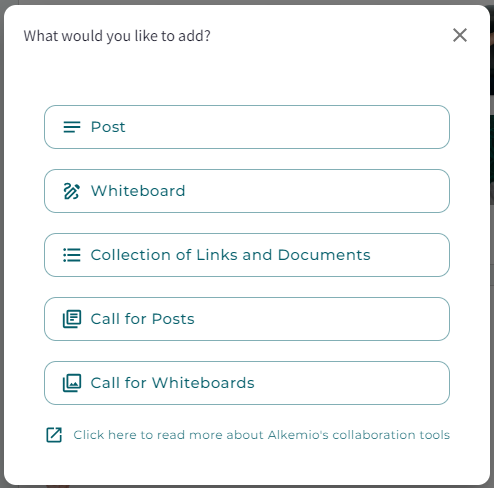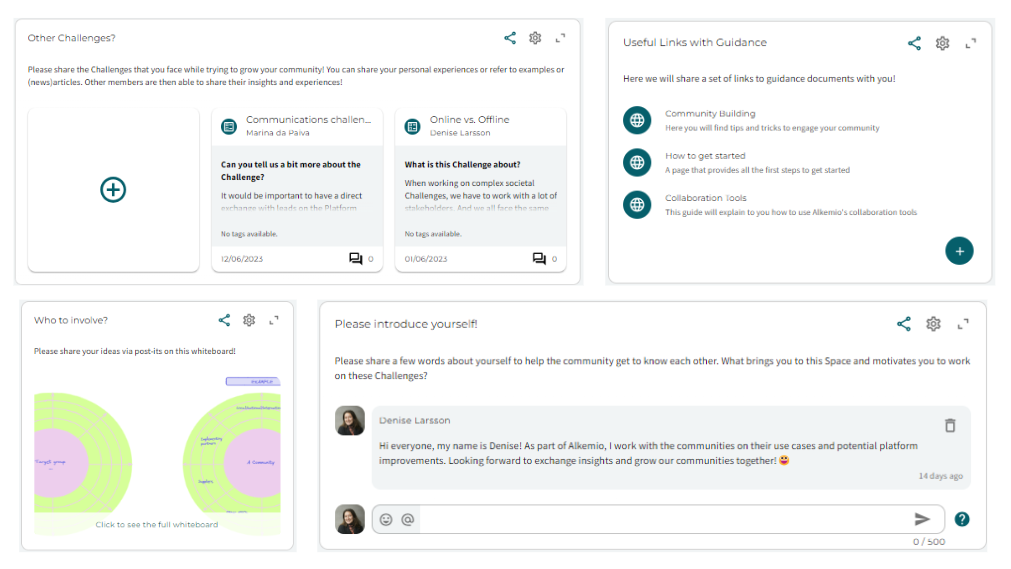How to use Alkemio’s collaboration tools?
Discussions with the Alkemio Community brought forward that users want to contribute in multiple ways: to growing the community, to framing challenges, to building up shared knowledge. This is now possible! Our selection of collaboration tools now offers you the ability to start collaborating directly in the context. Not in a separate document, or miro board, or spreadsheet, but directly in a Space where you have also gathered the community, the Subspaces, and the Knowledge base.
In this Support page, we will explain what types the platform offers, where you can use them, and how the use of our templates can help you.
Collaboration Tool Types
When working on a set of Subspaces, effective collaboration tools are essential for sharing information, gathering knowledge, and enabling interaction among community members. Depending on the context, you might need different ways to engage with your community. Here are the current collaboration tools available on the platform:
- A Post: Use this tool to initiate discussions, share messages (including guidance videos), or pose questions to the community. Members can respond with comments.
- A Whiteboard: Collaborate visually in real time. Multiple participants can add notes, drawings, or other visual elements to a stakeholder map or collectively sketch out the vision for a Subspace.
- A Collection of Links and Documents: Curate relevant materials by creating a set of links. This could include articles, blog posts, or guidance documents. Members can contribute by adding links along with brief descriptions.
- A Call for Posts: For more structured information gathering, use this tool. As a lead, you can include guiding questions or ask for specific information that members fill in. Responses can be more extensive, including references, tags, and visuals. Other members can also comment on each other’s responses.
- A Call for Whiteboards: When seeking multiple visual responses, consider using this tool. The lead can choose a template for members to follow—for instance, asking everyone to draw their vision for a particular challenge.
Feel free to explore these tools and adapt them to your community’s needs! 🚀

Where can I use these collaboration tools?
As mentioned before, the Hosts are now able to use these tools on any page! This allows them to ask the question where it makes the most sense. Let’s give you some examples:
- A Post on the Dashboard Tab to ask for comments, suggestions, feedback.
- A Collection of Links on the Dashboard Tab to share guiding materials to get started in this Space.
- A Whiteboard with a stakeholder map on the Community tab, so that the community can contribute with their insights about the current ecosystem
- A Post on the Community tab to ask members to introduce themselves or suggest other people / organizations to invite (see example below)
- A Call for Posts on the Subspaces tab where members can submit ideas for creating Subspaces to work in, by filling in a few context questions.
- A Call for Posts with relevant articles related to the topic on the Knowledge base tab

How can I use templates?
To guide you in creating these collaboration tools to activate your community, the Alkemio Innovation Library offers a set of templates. There is a lot of knowledge, best practices and templates out there related to innovation. Organizations as well as knowledge institutions often promote these materials via their websites or internal channels, but it is hard to find for the wider community. More importantly, it is hard to directly use when you want to start collaborating with multiple stakeholders. The platform offers an Innovation Library that gathers all these materials and makes them directly available for you to apply in your Space (more information on this Support Page).
These templates can be used both when you want to open a new callout as well as when you are submitting a new answer or contribution. Note that in principle the leads are able to open a new callout, but they can also choose to allow any member to open a new callout.
There are two relevant types of templates:
- Post templates
- Whiteboard templates
Post templates
These templates allow you to choose a set of default text or questions that each contribution must include. Hereby a few examples as inspiration:
- You want each user to start their answer with a user story. Then you would set as a default text for each post: As a … I want … so that … Each member can then submit their contribution in a more structured way using this template.
- You want users to submit relevant newsarticles related to a specific Subspace. Then you could state that each contribution must provide a description, why is this relevant for the Subspace, and source.
- You ask the community to share what organizations should be involved. Then you could let members answer a few questions. For example, why do you think this organization is relevant, how would you like to approach them, and do you need any help.
When starting a new Call for posts, you can define the default text to structure the answers of your community. When a member submits a new answer, they will be prompted to fill in these questions.
Whiteboard templates
Secondly, you can use our whiteboard templates to gather input from the community. You can think of templates for stakeholder maps, brainstorm sessions, innovation funnels, etc. When you start a new Whiteboard or a Call for Whiteboards, you can directly choose a template from the library of your Space or the platform’s Innovation Library. You can edit them to make it suitable for the particular question. Everytime a member wants to submit their contribution, they can use the whiteboard.
More settings for the Collaboration tools
There are several settings that will help you make the most of these collaboration tools. For example, you can …
- Move them up and down, or to the bottom or the top of the list as well as between the various pages.
- Share them with other people inside and outside of the platform.
- Expand the dialog to see a clearer overview of all contributions.
- Close them for answers. In the settings you can decide to turn the switch ‘Accept new responses’ on or off. Members are still able to see the previous answers and comment on them, but they cannot submit new ones.
- Create them in draft state, so that they are only visible for the admin. When the admin is ready to share it with the community, they can publish it (with the option to notify the community).
Let’s get started!
The current tools are just a glimpse of what they can offer you in the future, think of Polls, Stack Overflow, or other types of integrations. Have fun using them, share your experiences with other users of the platform, and share your feedback!